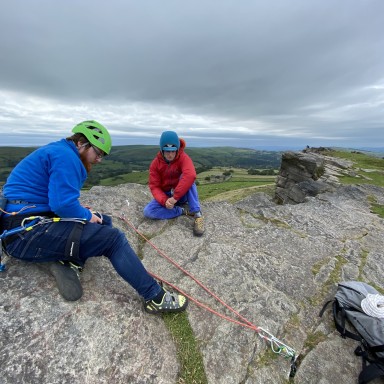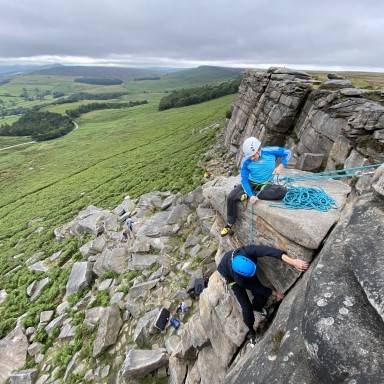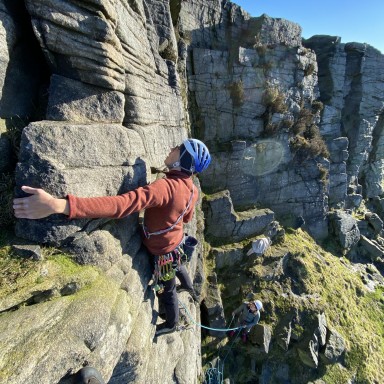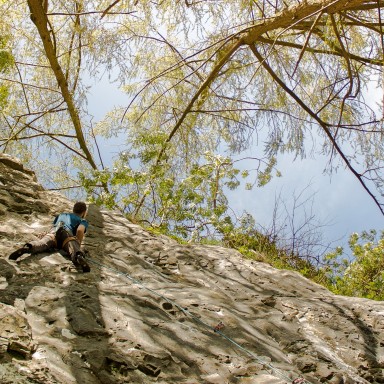
All about Carabiners!
Posted On: 07th June, 2020Crabs, no not the animal, the metal things you can clip into and they are a staple of any climber’s rack. In fact i'm not sure what we even did before they were invented?
Whether you're new to climbing or been climbing for years, with so many different types to buy theses days, it can be super confusing. Pear shapes, D shapes, Ovals, lockers, snappers? What’s the difference? Well here we will try our best to go through all the different types of carabiner and there uses so you know what goes where.
The shape of the crabs has a impact on how strong they are, how wide the gate will open and how it will be pulled when loaded. Firstly, one very important thing to know is that all carabiners have a strength rating. This is rated in Kilonewtons (KN) which is the dynamic force that the carabiner can take before it breaks (Some complicated maths is involved, but basically the higher the number the stronger it is). The ratings for each crab are split up into; Major Axis KN strength, Minor Axis KN strength and gate open KN strength and these can and do vary with the type of carabiner.
1 kN, is equivalent to 102.0 kgf, or about 100 kg of load under Earth gravity.
- Major axis strength is how strong a carabiner is pulled from the bottom and top. Minimum of 20KN
- Minor axis strength is how strong a carabiner is pulled across the gate and spine. Minimum of 7KN
- Gate open strength is how strong a carabiner is pulled from the bottom and top but with the gate open. Minimum of 6KN
Usually a stronger carabiner will be slightly heavier due to more material needed to increase the strength this is something you will have to consider and weigh up for yourself. Steel carabiners are some of the strongest but as climbers we tend to use lighter aluminium ones. One last thing to know about carabiners in general is that some have a hooked nose and some have a clean nose. What this means is with a clean nose, things slide in and out of the carabiner without getting caught and with a hooded nose rope, gear ect tends to ‘hook’ on the nose of the carabiner. Both types of nose can be found in both types of carabiner discussed below however clean noses are easier to work with but that comes at a cost!
Locking carabiners (Lockers)
Screwgates as they are more commonly known are everywhere, they come in a few different options. Some being a traditional screwgate with a barrel that screws closed over. Others however automatically lock themselves with varying combinations of twisting, pressing and magnets. The Former is the most common as it is simple and effective, the latter has a slightly more complex action to open but eliminates the forgetfulness aspect of keeping the carabiner locked! Some screw gates will also have a small snapgate inside the narrow end of the crab to be used to keep the orientation along the major axis, many people use this type for belaying with as it keeps everything straight. Choosing a crab is about picking the right shape for the intended job, once you have the shape the locking action is all down to personal preference.
Lockers also come in different shapes for different uses but any shape can normally be found with any of the locking options depending on your personal preference.
- Pear shaped (HMS) - usually used for Belay plates and for rigging as it has a larger gate opening that will accept knots easily.
- D Shaped - normally used for things such as building belays and clipping to gear, as the shape puts the forces through the straight side of the D into the strongest part of the carabiner. These tend to be the lightest form of Locking carabiner.
- Ovals – these are symmetrical in shape and can accept wider loads at both ends since one end isn’t narrower like a HMS style. I personally use these to belay with half ropes as they minimise cross loading across the crab
- Oversized – these are super useful for building belays and general rigging as they can accept multiple knots or clove hitches. A good example is a DMM Boa.
Snapgate Carabiners (wiregates)
Sometimes called snappers due to the snapping action again come in multiple different options and all have their pros and cons. Snapgates come in two main types. Solid and wire gates, normally you will find solid gates on sport climbing specific gear as they can be slightly heavier due to usually being left in a route for long periods of time and not on the harness and they are more hard wearing and can take a bit more abuse than there skimpy fiends. Wire gates can also be used on sport climbing kit but are more traditionally found on trad climbing specific kit as they are marginally lighter which matters when lugging loads of crabs up a route!
- Solid gate – sport climbing quickdraws tend to come with a Straight gate and a Bent gate. One is for the bolt and one is for easy clipping on that hard redpoint burn!
- Wiregates – Not much to say about these, they do what they say on the tin! You can however get super tiny fully rated ones at 19grams but be careful you don’t mistake an un-certified accessory crab as one of these. See the UIAA paragraph below!
- Oval – These can be found in Solid and Wire gate versions and tend to be used for racking wires onto as their large shape lets you find the wire you are looking for easier.
- Ergonomic shapes – Some solid gate crabs can be a funny shape down the spine. The bend is there to make the gate open further to help you clip into them with the rope usually when sport climbing.
One Last important thing about carabiners is that they are fit for the purpose of climbing. Some websites can sell dodgy or counterfeit gear for low prices that may be appealing but the gear then might be non-certified and could lead to injury. So, Check the gear you are about to buy has the relevant UIAA Certification. If in doubt go onto the UIAA website and look it up, that way you know it has been tested to within an inch of its life!
Hope this helped!
The PCS Team
Share this Article
Recent Blog Posts


D of E Kit List: The Ultimate Packing Guide
Posted: 16th February, 2025 Read Article
Sintra- Bouldering Destination Guide
Posted: 21st January, 2025 Read Article
What to Pack for a Climbing Course: An Essential Kit List
Posted: 14th January, 2025 Read Article





